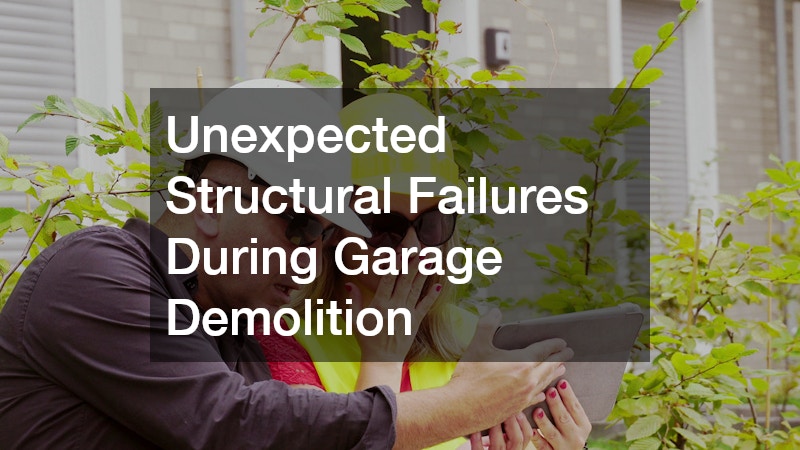Garage Demolition Disasters and How to Avoid Them
Garage demolition may seem like a straightforward task on the surface, but in reality, it’s a complex and potentially hazardous project that can quickly spiral out of control without the right knowledge and preparation. Many homeowners dive into garage demolition expecting a quick teardown, only to face costly delays, unexpected safety hazards, and even legal headaches. Understanding the common disasters that can occur can help save you time, money, and stress. In this guide, we reveal three of the most frequent demolition disasters garages experience and provide practical advice to help you avoid these pitfalls and complete your project smoothly.
Unexpected Structural Failures During Garage Demolition

One of the most alarming issues during residential demolition projects of any kind is the sudden failure of structural components that were not anticipated. Garages, especially older ones, often hide serious problems beneath the surface. Timber framing might be rotted, foundations could be cracked or undermined, or walls may have been built without following modern safety standards. When demolition begins without thorough inspection, these weaknesses can lead to parts of the garage collapsing prematurely.
This not only puts the demolition crew at risk of injury but also increases the chance of damage to nearby properties, vehicles, or landscaping. Structural failures often result in costly repairs, project delays, and a significant increase in labour costs because the job suddenly becomes much more complicated and dangerous.
In residential demolition projects, it’s important to include a detailed structural assessment to avoid these disasters. Hiring experienced demolition professionals is essential—they know what warning signs to look for and have the tools and expertise to safely dismantle fragile or unstable sections. Attempting DIY demolition on load-bearing walls or foundations is especially risky. Taking these safety precautions ensures everyone on site stays safe and your project proceeds without expensive surprises or dangerous setbacks.
Asbestos and Hazardous Materials Exposure Risks

Another serious concern during garage demolition, particularly with older buildings, is the presence of asbestos or other hazardous materials. Asbestos was commonly used in roofing sheets, insulation, wall cladding, and flooring before its health risks became widely known and regulations restricted its use. Disturbing asbestos-containing materials without proper precautions can release microscopic fibres into the air, which, when inhaled, cause severe respiratory illnesses including asbestosis, lung cancer, and mesothelioma.
Many garages built before the 1990s may contain asbestos, and it’s crucial to handle this risk carefully during residential demolition. The only safe way to manage asbestos is to commission a licensed asbestos inspection before starting demolition. If asbestos is detected, removal must be carried out by certified professionals who follow strict safety protocols—sealing off the work area, using specialised protective equipment, and disposing of materials according to legal requirements. Attempting asbestos removal yourself is both dangerous and illegal in many areas.
Prioritising asbestos testing and removal protects your health, ensures compliance with Australian workplace safety laws, and prevents costly legal penalties. It’s an essential step no demolition project should overlook.
Costly Delays Caused by Permitting and Planning Errors

Many demolition projects run into trouble simply because of poor planning and failure to comply with local regulations. Obtaining the correct permits and approvals is often overlooked or misunderstood by homeowners, leading to unexpected fines, forced work stoppages, or even legal action. Each local council in Australia has its own set of rules about demolition work, including requirements for notification, disposal of waste, and environmental protection measures. Ignoring these regulations or starting demolition before permits are issued can lead to costly delays that stall your project indefinitely.
Planning errors also include failing to schedule essential pre-demolition steps such as disconnecting utilities—which is necessary to prevent accidents on site. Additionally, neglecting to notify neighbours about demolition work can cause disputes or complaints that may result in further interruptions.
Waste management is another commonly overlooked area. Garage demolition produces a significant amount of debris, and without a clear plan for rubbish removal and onsite recycling, projects can face delays, increased costs, and environmental penalties. Incorporating onsite recycling practices helps separate and divert materials like timber, metals, and concrete from landfill, reducing waste disposal fees and speeding up cleanup.
Delays caused by poor communication, insufficient budgeting, or mismanagement of subcontractors are common and often avoidable with proper organisation. The best way to prevent these problems is to engage with your local council early in the process to fully understand what permits and documentation you need. Develop a detailed demolition plan that includes realistic timelines, a budget that accounts for all costs (including unexpected ones), and clear responsibilities for everyone involved. Coordinating with utility providers to safely disconnect services before demolition starts is critical to avoid hazards and keep the project on track. Good planning, combined with an effective onsite recycling strategy, ensures you meet legal requirements, protect the environment, and keep your demolition project moving smoothly.
If you’re planning a garage demolition, don’t leave it to chance. With careful preparation and expert guidance, you can avoid these common disasters and turn your demolition into the successful foundation for your next home improvement project.
